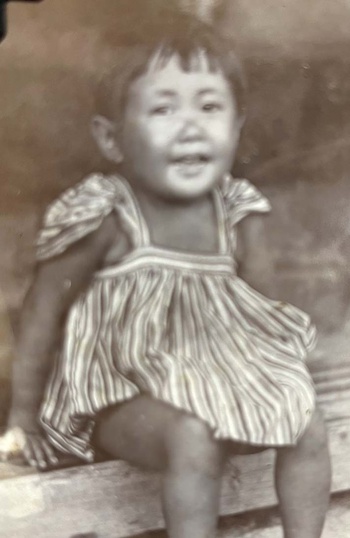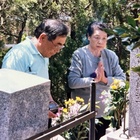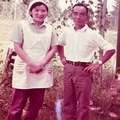Exile to Japan
John and May were among those Japanese Canadians who made the difficult choice of exile to Japan at the end of the war rather than forced dispersal to eastern Canada. Their reasons for doing so and which of them made the final decision are still rather unclear. The eldest daughter Megumi speculates:
I’m not sure why. Perhaps it was Father who decided as Mother had been born and raised in Canada. She had siblings there. She had neither close relatives nor acquaintances here in Japan.... Father’s parents were still alive in his hometown... It is written here in his diary... It was not because of his parents. Every day he was wrestling with the decision whether to stay in Canada or return to Japan, and finally made a sudden gut-decision to return. He wrote about it here in his diary. I think he really wrestled with the decision and wasn’t sure what to do.
Basil has no recollection of John ever explaining the reasons for this choice, nor even talking about it. However, many years later, May told him that she was the one who had made the decision, and Basil speculates she did so out of anger at how Japanese Canadians had been unjustly treated by the Canadian government. It is known that her sisters and mother did their best to persuade her not to go, but without success.
The Izumi family were taken to Japan aboard the General Meigs, the largest of three ships chartered by the Canadian government for the deportations of Japanese Canadians. Basil was nine years old at the time, Megumi was two, and the youngest child, Emiko, experienced her first birthday during the trip. The ship arrived at the repatriation center in Yokosuka, where they stayed while arrangements were being made for transportation to John’s home village, Shimosato.
Basil recalls that the weather was very hot and the quality of the food they received was extremely poor. Megumi has a vague memory of the repatriation center, specifically being surrounded by a lot of people whose way of speaking seemed very strange to her. She even remembers the people’s faces though she does not recall the bad food. She also remembers looking up at the moon, longing for Canada and crying. Several days later they made the journey by train to Shimosato.
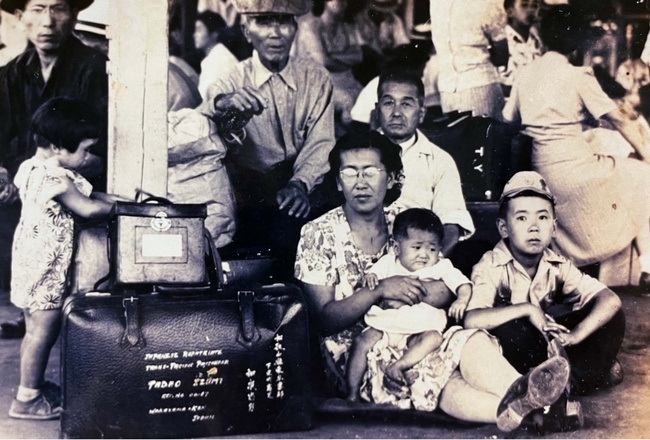
Early Childhood in Shimosato, Wakayama Prefecture
After arriving in Shimosato (summer of 1946), they lived with John’s parents. May experienced an extremely difficult relationship with John’s mother. Megumi recalls her mother trying hard to please her mother-in-law, and in particular an occasion when May dressed herself and her daughters up in kimonos, perhaps in an attempt to win her approval. These efforts failed, and within a few months May left the family in Shimosato and went to work as a translator, simultaneous interpreter, and typist for the American Occupation Forces at various bases in Osaka, Kyoto and Otsu.
John continued to live with the children in Shimosato but was often away from the home due to his photography business and other activities. Basil remembers his father “coming and going” but does not recall specifically what kind of work he was doing. John had enjoyed a successful career as a photographer in Vancouver and had taken numerous photos of life in the internment camps, and he was able to continue his work as a photographer after returning to Shimosato.
In those days, cameras were precious items, so people with money requested his services and paid him well. The sisters recall that he converted a closet in his parents’ house into a photo developing room. He was good at taking photographs of people in natural settings but was not qualified to take formal portrait photographs. Megumi explains:
He could not do formal portraits such as weddings because that required the photographer to be able to specially arrange the bride’s kimono...Japanese photographers must be able to pay attention to small details such as arranging the hem and sleeves of the kimono and doing so in such a way as to properly show the pattern and so on, but Father did not know how to do that. So, instead he was hired by various people to take photos that showed them in natural situations. He took color photographs and he added colors to black and white photographs, and he received high satisfaction from his customers.
Apparently John was very strict and short-tempered towards the children. The daughters vividly recall him angrily scolding them when they tried to enter his photo developing room. He was often out of the house due to his photography business and his frequent drinking with relatives and friends. Megumi says, “It was really hard for us kids. Father, although he was busy with his work, often went drinking with village people. Many of his relatives lived nearby and he would take them by train to Katsura, which was several stops away. I heard they would go there to drink and spend money.”
Some of Megumi and Emiko’s earliest memories concern their paternal grandmother. To them she was a stern and frightening figure and did not help much with their care. At first, most of her anger was directed at her daughter-in-law May, perhaps due in part to the strict expectations Japanese mothers-in-law in that time had of their daughters-in-law. May, who was born and raised in Canada, seems to have found these expectations impossible to live up to, no matter how hard she tried.
When May left the family and went to work for the occupying forces, her mother-in-law became more upset and directed much of her anger at the children. Basil recalls her being prone to angry outbursts. Emiko recalls often being scolded by her for just eating food and remembers her even refusing to give the children treats sent to them by their mother:
Grandmother would not allow us to eat even one of the canned cookies mother sent for us after she had left for Osaka. We had cousins in Katsura, so she gave the cookies to them instead, even though Mother had sent them for us. We never forgot that.
In contrast, the sisters’ early memories of their older brother Basil and his care of them are very fond. Because May had left and John was often out of the house, Basil took on much of the role of a surrogate parent, such as standing in line to receive food rations for the family, feeding his sisters, and even changing and washing their diapers. Megumi specifically recalls Basil mixing a flour-like material with water to make a chewy substance and giving it to her as a kind of chewing gum.
Basil really took care of us, really! ...We remember receiving sweets and so on from Basil. Basil always went to receive the rations. Once, as a prank, he tricked us into biting into some soap he had received that he pretended was a kind of sweets.
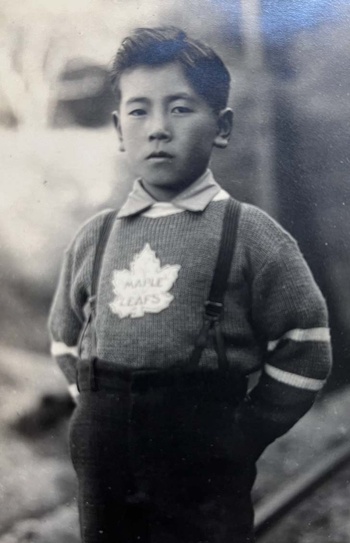
Basil enrolled in elementary school but, due to his limited Japanese (especially reading and writing), was moved back to grade one although he didn’t have a particularly difficult time communicating with teachers or classmates. Even as a nine-year-old child-exile in Japan, he was proud of being Canadian, and his trademark was his Toronto Maple Leafs sweater which he wore proudly. He explains as follows:
In those days they did not distinguish between Canada and America and called me an American. I resented being called an American rather than a Canadian, and at least once got into a fight about that. At that time I had long hair, so I had my dad cut it off and I became a bozu (shaved head) like the other kids because the other kids could pull my hair in a fight if it was longer. I got into the normal fights that normal kids get into, but I do not recall being picked on for being a foreigner. I just resented being called an American.
Fortunately, he was strong and athletic and found that his baseball skills gained him some respect from the other kids.
To be continued ...
© 2021 Stan Kirk


